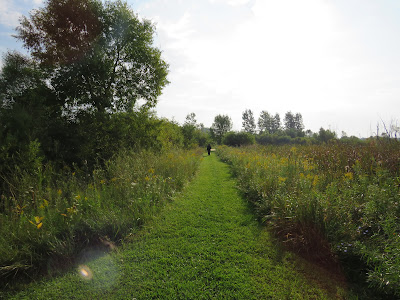It’s late morning as I watch the glistening water of 10 ft.-wide, Corbin Creek flow east through a culvert under Douglas Rd, in northeastern Montcalm County. Under partly sunny skies and temperatures in the mid 60’s, I continue my exploration of this watercourse, upstream to its source. While observing the lush creek bank, I’m surprised to hear the sound of a Spring Peeper. Usually, a chorus of these tiny amphibians (stock photo) emanate from the wetlands in early spring. However, if similar conditions occur in the fall, like short days, cool temperatures and moderate rainfall, a sporadic peep can be heard. Leaving the road, I follow the creek bank where I spot the yellow blossoms of Beggar’s-ticks and the orange blossoms of Jewelweed. Jewelweed contains chemical compounds that counteract the itchy, blistered rash that often occurs from contact with Poison Ivy. Applying sap from this plant immediately after contact can help stop the rash. Up ahead, I pause to look for and listen to a few Sandhill Cranes flying overhead. In mid/late October to late November these large, colorful birds will migrate to Texas, New Mexico, Mexico and Arizona. Trudging through the pathless, floodplain, I come upon a ½ inch, perching Crane Fly. During their two-week life span they don’t eat. Adults mate on plants or in the air near the water. Afterwards, the female deposits her eggs. When mating and egg distribution is complete, both the male and female die. The larval stage (stock photo) can last anywhere from a few weeks to one year. During this time, larvae are important for recycling and decomposition – they eat leaves, plants and small bits of organic material in the soil or water bodies. Next, I walk a short distance south to another section of the creek where the bright red leaves of Virginia Creeper are on display. Likewise, I notice the bright red fruit of Winterberry and Highbush cranberry. Highbush cranberry is actually not a cranberry at all, though its fruit strongly resembles true lowbush cranberries (stock photo) in both appearance and taste. They also mature in the fall, as cranberries do. The fruit can be eaten raw or cooked, and like cranberries, they are rich in vitamin C and so have a tart, acid taste. They are an excellent substitute for cranberries and are likewise used in preserves, jams, jellies and sauces. Making my way, along the road back to the car, I spot a single blossom of Sow Thistle and several blossoms of Sky-blue Aster. Near the car, I pause at the clearing to enjoy the music of an Orthopteran chorus of grasshoppers, crickets and katydids.
I welcome these days
When the Egret flies thru
Creeper leaves glow red
Their berries shine blue
I welcome the sun
On its annual descent
Geese are gathering
The meadow is spent
I welcome the morning
Cool and clear
Greetings autumn!
Glad you’re here
D. DeGraaf



